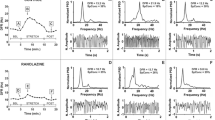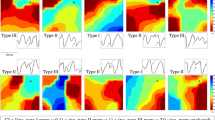Abstract
Purpose
Mechanical stretch increases sodium and calcium entry into myocytes and activates the late sodium current. GS967, a triazolopyridine derivative, is a sodium channel blocker with preferential effects on the late sodium current. The present study evaluates whether GS967 inhibits or modulates the arrhythmogenic electrophysiological effects of myocardial stretch.
Methods
Atrial and ventricular refractoriness and ventricular fibrillation modifications induced by acute stretch were studied in Langendorff-perfused rabbit hearts (n = 28) using epicardial multiple electrodes and high-resolution mapping techniques under control conditions and during the perfusion of GS967 at different concentrations (0.03, 0.1, and 0.3 μM).
Results
On comparing ventricular refractoriness, conduction velocity and wavelength obtained before stretch had no significant changes under each GS967 concentration while atrial refractoriness increased under GS967 0.3 μM. Under GS967, the stretch-induced changes were attenuated, and no significant differences were observed between before and during stretch. GS967 0.3 μM diminished the normal stretch-induced changes resulting in longer (less shortened) atrial refractoriness (138 ± 26 ms vs 95 ± 9 ms; p < 0.01), ventricular refractoriness (155 ± 18 ms vs 124 ± 16 ms; p < 0.01) and increments in spectral concentration (23 ± 5% vs 17 ± 2%; p < 0.01), the fifth percentile of ventricular activation intervals (46 ± 8 ms vs 31 ± 3 ms; p < 0.05), and wavelength of ventricular fibrillation (2.5 ±0.5 cm vs 1.7 ± 0.3 cm; p < 0.05) during stretch. The stretch-induced increments in dominant frequency during ventricular fibrillation (control = 38%, 0.03 μM = 33%, 0.1 μM = 33%, 0.3 μM = 14%; p < 0.01) and the stretch-induced increments in arrhythmia complexity index (control = 62%, 0.03μM = 41%, 0.1 μM = 32%, 0.3 μM = 16%; p < 0.05) progressively decreased on increasing the GS967 concentration.
Conclusions
GS967 attenuates stretch-induced changes in cardiac electrophysiology.









Similar content being viewed by others
References
Kondratev D, Christ A, Gallitelli MF. Inhibition of the Na+-H+ exchanger with cariporide abolishes stretch-induced calcium but not sodium accumulation in mouse ventricular myocytes. Cell Calcium. 2005;37:69–80.
Cingolani HE, Perez NG, Cingolani OH, Ennis IL. The Anrep effect: 100 years later. Am J Physiol Heart Circ Physiol. 2013;304:H175–82.
Von Lewinski D, Stumme B, Maier LS, Luers C, Bers DM, Pieske B. Stretch-dependent slow force response in isolated rabbit myocardium is Na+ dependent. Cardiovasc Res. 2003;57:1052–61.
Quinn TA, Kohl P. Rabbit models of cardiac mechano-electric and mechano-electric and mechano-mechanical coupling. Prog Biophys Mol Biol. 2016;121:110–22.
Kim D. Novel cation-selective mechanosensitive ion channel in the atrial cell membrane. Circ Res. 1993;72:225–31.
Beyder A, Rae JL, Bernard C, Strege PR, Sachs F, Farrugia G. Mechanosensitivity of Nav1.5, a voltage-sensitive sodium channel. J Physiol. 2010;588:4969–85.
Peyronnet R, Nerbonne JM, Kohl P. Cardiac mechano-gated ion channels and arrhythmias. Circ Res. 2016;118:311–29.
Sag CM, Wagner S, Maier LS. Role of oxidants on calcium and sodium movement in healthy and diseased cardiac myocytes. Free Radic Biol Med. 2013;63:338–49.
Prosser BL, Ward CW, Lederer WJ. X-ROS signaling is enhanced and graded by cyclic cardiomyocyte stretch. Cardiovasc Res. 2013;98:307–14.
Patlak JB, Ortiz M. Slow currents through single sodium channels of the adult rat heart. J Gen Physiol. 1985;86:89–104.
Maltsev VA, Undrovinas A. Late sodium current in failing heart: friend or foe? Prog Biophys Mol Biol. 2008;96:421–51.
Wei XH, Yu SD, Ren L, Huang SH, Yang QM, Wang P, et al. Inhibition of late sodium current suppresses calcium-related ventricular arrhythmias by reducing the phosphorylation of CaMK-II and sodium channel expressions. Sci Rep. 2017;7:981.
Yao L, Fan P, Jiang Z, Viatchenko-Karpinski S, Wu Y, Kornyeyev D, et al. Nav1.5-dependent persistent Na+ influx activates CaMKII in rat ventricular myocytes and N1325S mice. Am J Physiol Cell Physiol. 2011;301:C577–86.
Ma J, Luo A, Wu L, Wan W, Zhang P, Ren Z, et al. Calmodulin kinase II and protein kinase C mediate the effect of increased intracellular calcium to augment late sodium current in rabbit ventricular myocytes. Am J Physiol Cell Physiol. 2012;302:C1141–51.
Antzelevitch C, Burashnikov A, Sicouri S, Belardinelli L. Electrophysiological basis for the antiarrhythmic actions of ranolazine. Heart Rhythm. 2011;8:1281–90.
Verrier RL, Kumar K, Nieminen T, Belardinelli L. Mechanisms of ranolazine’s dual protection against atrial and ventricular fibrillation. Europace. 2013;15:317–24.
Chorro FJ, del Canto I, Brines L, Such-Miquel L, Calvo C, Soler C, et al. Ranolazine attenuates the electrophysiological effects of myocardial stretch in Langendorff perfused rabbit hearts. Cardiovasc Drugs Ther. 2015;29:231–41.
Belardinelli L, Liu G, Smith-Maxwell C, Wang WQ, el-Bizri N, Hirakawa R, et al. A novel, potent, and selective inhibitor of cardiac late sodium current suppresses experimental arrhythmias. J Pharmacol Exp Ther. 2013;344:23–32.
Sicouri S, Belardinelli L, Antzelevitch C. Antiarrhytmic effects of the highly selective late sodium channel current blocker GS-458967. Heart Rhyhm. 2013;10:1036–43.
Koltun DO, Parkhill EQ, Elzein E, Kobayashi T, Notte GT, Kalla R, et al. Discovery of triazolopyridine GS-458967, a late sodium current inhibitor (late INai) of the cardiac NaV 1.5 channel with improved efficacy and potency relative to ranolazine. Bioorg Med Chem Lett. 2016;26:3202–6.
Bonatti R, Silva AF, Batatinha JA, Sobrado LF, Machado AD, Varone BB, et al. Selective late sodium current blockade with GS-458967 markedly reduces ischemia-induced atrial and ventricular repolarization alternans and ECG heterogeneity. Heart Rhythm. 2014;11:1827–35.
Alves Bento AS, Bacic D, Saran Carneiro J, Nearing BD, Fuller H, Justo FA, et al. Selective late INa inhibition by GS-458967 exerts parallel suppression of catecholamine-induced hemodynamically significant ventricular tachycardia and T-wave alternans in an intact porcine model. Heart Rhyhm. 2015;12:2508–14.
Carneiro JS, Bento AS, Bacic D, Nearing BD, Rajamani S, Belardinelli L, et al. The selective cardiac late sodium current inhibitor GS-458967 suppresses autonomically triggered atrial fibrillation in an intact porcine model. J Cardiovasc Electrophysiol. 2015;26:1364–9.
Chorro FJ, Trapero I, Guerrero J, Such LM, Canoves J, Mainar L, et al. Modification of ventricular fibrillation activation patterns induced by local stretching. J Cardiovasc Electrophysiol. 2005;16:1087–96.
Chorro FJ, Trapero I, Such-Miquel L, Pelechano F, Mainar L, Cánoves J, et al. Pharmacological modifications of the stretch-induced effects of ventricular fibrillation in perfused rabbit-hearts. Am J Physiol Heart Circ Physiol. 2009;297:H1860–9.
Such-Miquel L, Chorro FJ, Guerrero J, Trapero I, Brines L, Zarzoso M, et al. Evaluation of the complexity of myocardial activation during ventricular fibrillation. An experimental study. Rev Esp Cardiol. 2013;66:177–84.
Burashnikov A, Di Diego JM, Robert J, Goodrow RJ, Belardinelli L, Antzelevitch C. Atria are more sensitive than ventricles to GS-458967-induced inhibition of late sodium current. J Cardiovasc Pharmacol Ther. 2015;20:501–8.
Weiss JN, Chen PS, Qu Z, Karagueuzian HS, Garfinkel A. Ventricular fibrillation: how do we stop the waves from breaking? Circ Res. 2000;87:1103–7.
Del Canto I, Such-Miquel L, Brines L, Soler C, Zarzoso M, Calvo C, et al. Effects of JTV-519 on stretch-induced manifestations of mechanoelectric feedback. Clin Exp Pharmacol Physiol. 2016;43:1062–70.
Pezhouman A, Madahian S, Stepanyan H, Ghukasyan H, Qu Z, Belardinelli L, et al. Selective inhibition of late sodium current suppresses ventricular tachycardia and fibrillation in intact rat hearts. Heart Rhythm. 2014;11:492–501.
Potet F, Vanoye CG, George AL. Use-dependent block of human cardiac sodium channels by GS967. Mol Pharmacol. 2016;90:52–60.
Chorro FJ, Canto ID, Brines L, Such-Miquel L, Calvo C, Soler C, et al. Experimental study of the effects of EIPA, losartan, and BQ-123 on electrophysiological changes induced by myocardial stretch. Rev Esp Cardiol. 2015;68:1101–10.
Ravelli F, Allessie MA. Effects of atrial dilatation on refractory period and vulnerability to atrial fibrillation in the isolated Langendorff-perfused rabbit heart. Circulation. 1997;96:1686–95.
Reiter MJ, Synhorst DP, Mann DE. Electrophysiological effects of acute ventricular dilatation in the isolated rabbit heart. Circ Res. 1988;62:554–62.
Chorro FJ, Egea S, Mainar L, Cánoves J, Sanchis J, Llavador E, et al. Acute modifications in the wavelength of the atrial excitation process induced by stretching. An experimental study. Rev Esp Cardiol. 1998;51:874–83.
Iribe G, Jin H, Kaihara K, Naruse K. Effects of axial stretch on sarcolemmal BKCa channels in post-hatch chick ventricular myocytes. Exp Physiol. 2010;95:699–711.
Calaghan SC, Belus A, White E. Do stretch-induced changes in intracellular calcium modify the electrical activity of cardiac muscle? Progr Biophys Mol Biol. 2003;82:81–95.
Zhao HC, Agula H, Zhang W, Wang F, Sokabe M, Li LM. Membrane stretch and cytoplasmic Ca2+ independently modulate stretch-activated BK channel activity. J. Biomechanics. 2010;43:3015–9.
Isenberg G, Kazanski V, Kondratev D, Gallitelli MF, Kiseleva I, Kamkin A. Differential effects of stretch and compression on membrane currents and [Na+]c in ventricular myocytes. Progr Biophys. Mol Biol. 2003;82:43–56.
Kelly D, Mackenzie L, Hunter P, Smaill B, Saint DA. Gene expression of stretch-activated channels and mechanoelectric feedback in the heart. Clin Exp Pharmacol Physiol. 2006;33:642–8.
Decher N, Kiper AK, Rinné S. Stretch-activated potassium currents in the heart: focus on TREK-1 and arrhythmias. Progr Biophys Mol Biol. 2017;130:223–32.
Carmeliet E. Action potential duration, rate of stimulation, and intracellular sodium. J Cariovasc Electrophysiol. 2006;17(Suppl. I):S2–7.
Wu L, Ma J, Li H, Wang C, Grandi E, Zhang P, et al. Late sodium current contributes to the reverse rate-dependent effect of Ikr inhibition on ventricular repolarization. Circulation. 2011;123:1713–20.
Despa S, Bers DM. Na+ transport in the normal and failing heart—remember the balance. J Mol Cell Cardiol. 2013;61:2–10.
Burashnikov A. Late INa inhibition as an antiarrhythmic strategy. J Cardiovasc Pharmacol. 2017;70:159–67.
Zygmunt AC, Nesterenko VV, Rajamani S, Hu D, Barajas-Martinez H, Belardinelli L, et al. Mechanisms of atrial-selective block of Na+ channels by ranolazine: I. Experimental analysis of the use-dependent block. Am J Physiol Heart Circ Physiol. 2011;301:H1606–14.
Kornyeyev D, El-Bizri N, Hirakawa R, Nguyen S, Viatchenko-Karpinski S, Yao L, et al. Contribution of the late sodium current to intracellular sodium and calcium overload in rabbit ventricular myocytes treated by anemone toxin. Am J Physiol Heart Circ Physiol. 2016;310:H426–35.
Janvier NC, Boyett MR. The role of Na-Ca exchange current in the cardiac action potential. Cardiovasc Res. 1996;32:69–84.
Karagueuzian HS, Pezhouman A, Angelini M, Olcese R. Enhanced late Na and Ca currents as effective antiarrhythmic drug targets. Front Pharmacol. 2017;8
Remme CA, Bezzina CR. Sodium channel (Dys) function and cardiac arrhythmias. Cardiovasc Ther. 2010;28:287–94.
Scirica BM, Morrow DA, Hod H, Murphy SA, Belardinelli L, Hedgepeth CM, et al. Effect of ranolazine, an antianginal agent with novel electrophysiological properties, on the incidence of arrhythmias in patients with non ST-segment elevation acute coronary syndrome: results from the metabolic efficiency with ranolazine for less ischemia in non ST-elevation acute coronary syndrome thrombolysis in myocardial infarction 36 (MERLIN-TIMI 36) randomized controlled trial. Circulation. 2007;116:1647–52.
Shenasa M, Assadi H, Heidary S, Ranolazine SH. Electrophysiologic effect, efficacy, and safety in patients with cardiac arrhythmias. Card Electrophysiol Clin. 2016;8:467–79.
Yu S, Li G, Huang CLH, Lei M, Wu L. Late sodium current associated cardiac electrophysiological and mechanical dysfunction. Pflugers Arch - Eur J Physiol. 2018;470:461–9.
Gong M, Zhang Z, Fragakis N, Korantzopoulos P, Letsas KP, Li G, et al. Role of ranolazine in the prevention and treatment of atrial fibrillation: a meta-analysis of randomized clinical trials. Heart Rhythm. 2017;14:3–11.
Funding
This work was supported by the Spanish Ministry of Economy and Competiveness (Carlos III Health Institute)/European Regional Development Fund (FEDER) (Grants FIS PI12/00407, PI15/01408, PIE15/00013, CB16/11/00486) and by the Generalitat Valenciana (Grant PROMETEO FASE II 2014/037).
Author information
Authors and Affiliations
Corresponding author
Ethics declarations
Conflicts of Interest
The authors declare that they have no competing interests.
Ethical Approval
All applicable international, national, and/or institutional guidelines for the care and use of animals were followed.
Rights and permissions
About this article
Cite this article
del Canto, I., Santamaría, L., Genovés, P. et al. Effects of the Inhibition of Late Sodium Current by GS967 on Stretch-Induced Changes in Cardiac Electrophysiology. Cardiovasc Drugs Ther 32, 413–425 (2018). https://doi.org/10.1007/s10557-018-6822-x
Published:
Issue Date:
DOI: https://doi.org/10.1007/s10557-018-6822-x




